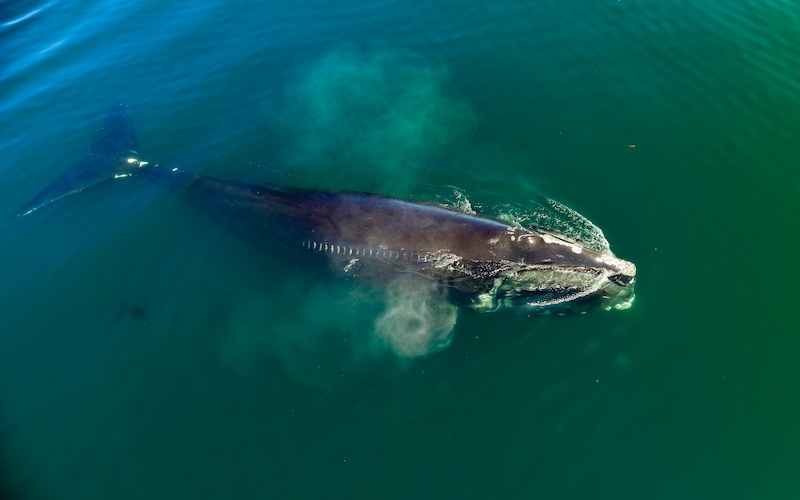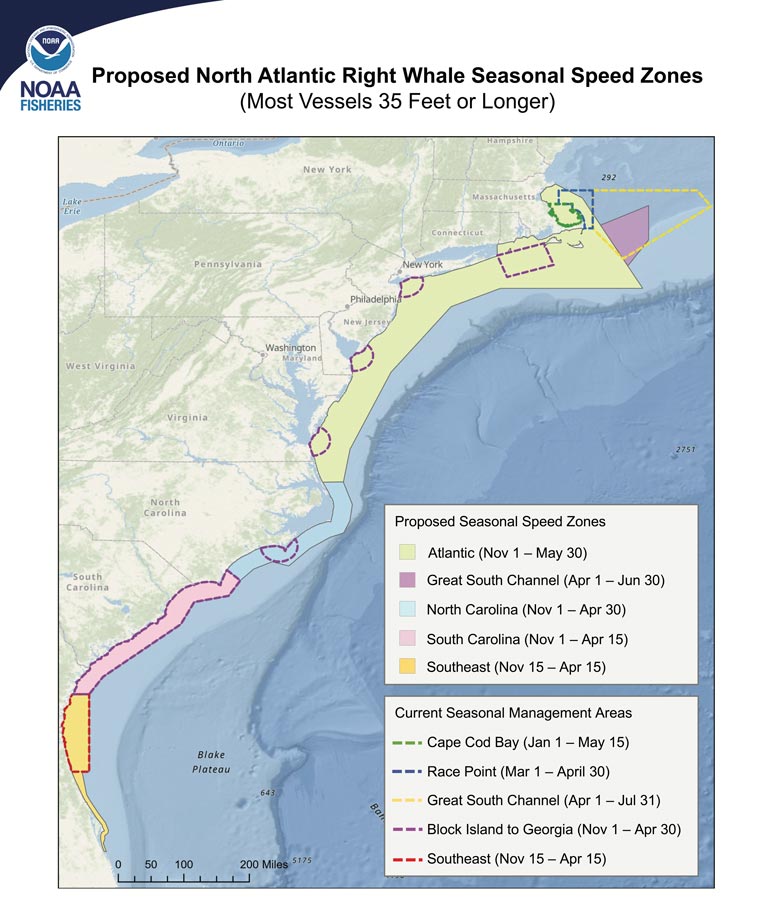
New proposed rules to protect North Atlantic right whales promise to make a difference for this species. Your voice can help the government move these rules forward. Photo: Brian Skerry/Steve De Neef, NOAA permit #21371.
In 2022, a one-month-old right whale calf died when hit by a sportfishing boat off the coast of Florida. The calf’s mom, named “Infinity,” was also struck and is believed to have perished. The strike forced the captain to seek out a landing to get his passengers to safety – managing to get his boat onto a mudflat.
Only around 350 right whales remain on the planet today. Scientists have determined that we cannot afford to lose even a single whale. Yet, right whale injuries and fatalities from accidental collisions with vessels (boats and ships) have become more and more common. Since 2017, speeding vessels have struck and killed at least eleven of these endangered whales.
These deaths are even more tragic because they are avoidable. To protect right whales, the federal government must take strong measures to regulate vessel speeds in areas important to right whales.
CLF and our partners have been pushing regulators at NOAA Fisheries to do just that. NOAA has released a promising proposal that will better protect right whales from deadly vessel strikes.
We support NOAA’s proposed rules. We need you to speak up for right whales, too. NOAA is looking for your input to finalize these regulations. Please, tell NOAA that support the proposed new measures to make our ocean safer for whales and people.
Vessel Strikes Threaten the Survival of Right Whales
While vessel strikes present a risk to all large whales, our critically endangered North Atlantic right whales are particularly at risk.
Vessel strikes cause almost half of all right whale deaths today (accidental entanglements in fishing gear account for the rest). Those whales that survive an initial collision may later die from their wounds or bear the scars for the rest of their lives. Healing from the trauma can take years and can prevent a whale’s ability to swim, feed, socialize, reproduce, and raise its calves.
Given the dire situation of this species, even one death is too many. Slowing down vessels in areas where right whales gather can help prevent these accidents.
Slow Down for Right Whales
Right whales are slow swimmers – they seem to prefer a calm pace with an average speed of just 0.7 knots (~0.8 mph). But even at top speed, they can only reach 2.9 knots (~3.3 mph). Sadly, this makes it difficult for them to dodge speeding vessels. On top of this, right whales feed just below the surface. This makes it especially challenging for boats and ships to spot them.
Slowing down can help. Researchers estimate that limiting vessel speeds to 10 knots (~12 mph) can reduce the risk of a right whale death by 80% to 90%. This will give whales and boaters a better chance of detecting each other and avoiding a collision.
Fintastic News for Right Whales
Under NOAA’s current rules for vessels, speed restrictions apply only to vessels over 65 feet in length – and only in select areas and during a limited time of the year.
The new proposal would strengthen existing measures to give right whales a fighting chance. Here’s how:
-
Speed Restrictions Would Apply to Smaller Vessels:
The new rule proposes to require all boats larger than 35 feet to slow down when entering a designated speed restriction zone. The boat that accidentally struck “Infinity” and killed her newborn was 54 feet long. Smaller vessels like this one are increasingly striking whales, causing deaths or injuries. This change will help protect whales and people. - More Areas Along the Atlantic Coast Will Require Speed Restrictions:
The proposal would expand the extent of current speed reduction zones that run from Massachusetts down to the northern coast of Florida.
This proposed change is critical because rapidly warming waters have shifted where whales can find their primary food sources. Today, right whales forage in places they were not seen 10, 15, or even 20 years ago. Right whales spend more time in the Gulf of Saint Lawrence, the mid-Atlantic, and many more unknown places.
Currently, speed reduction zones exist for a handful of places along the eastern seaboard. And those speed restrictions apply only during certain times of the year. So, if a boat spots a whale in the “off-season,” when restrictions don’t apply, it can choose to slow down (or not). The proposed rules would expand seasonal speed zones in areas with heavy vessel traffic, high levels of risk, and persistent whale presence. The new rules also propose including dynamic speed zones, making it mandatory for boats to slow down to 10 knots when three or more right whales are present – even in the off-season.

The New Proposal Could Make a Difference for Vulnerable Whales
NOAA’s proposed rules would greatly reduce vessel strikes. But to truly make a difference for the species, NOAA needs to strengthen some of the proposed protections:
- The new rules must set year-round speed restrictions in critical areas. Researchers have found that the greatest risk of vessel strikes occurs throughout the mid-Atlantic and southern New England’s waters. For example, right whales now forage and raise their calves south of Martha’s Vineyard and Nantucket, Massachusetts, year-round. The new rules must take these new migratory patterns into account.
- The dynamic speed zones must be triggered by two whales, not three. As proposed, the new dynamic speed zones will reduce right whale deaths. However, vessel strikes have taken a tremendous toll on mother and calf pairs. The proposed trigger of three whales would continue to leave pairs like Infinity and her newborn calf unprotected.
Take Action for Right Whales
With calving season underway, we must get these new measures on the water swiftly. Opposition to the new rule means we must make our voices louder to protect this endangered species.
Take action before vulnerable calves are killed. Tell regulators you support the proposed rules and that you want to see them made even stronger. And don’t forget: go slow—whales below.




